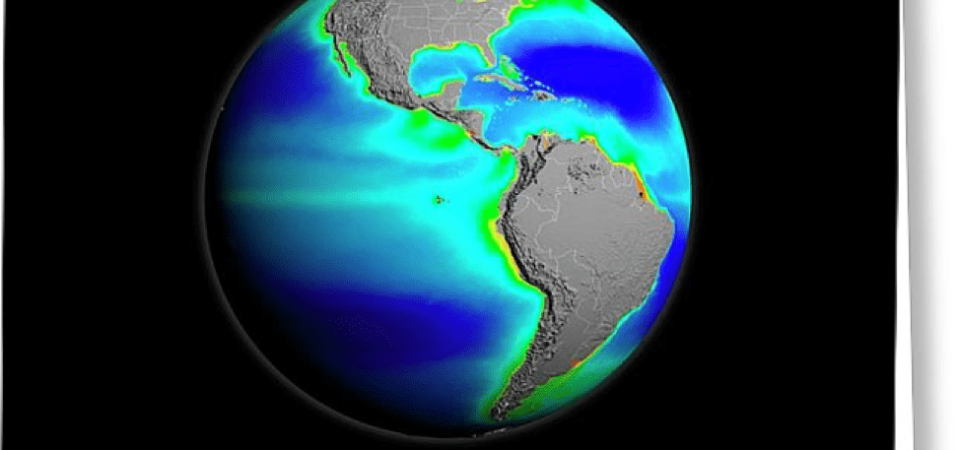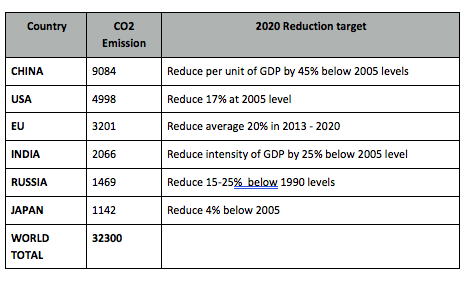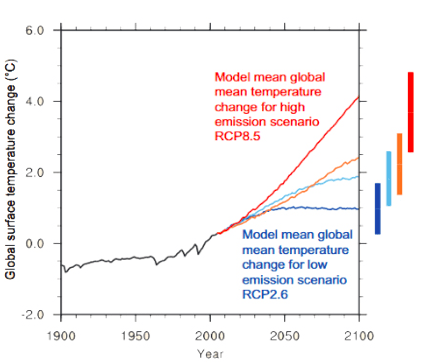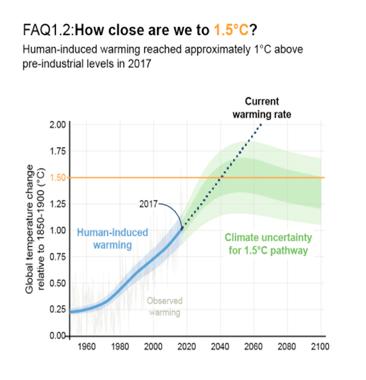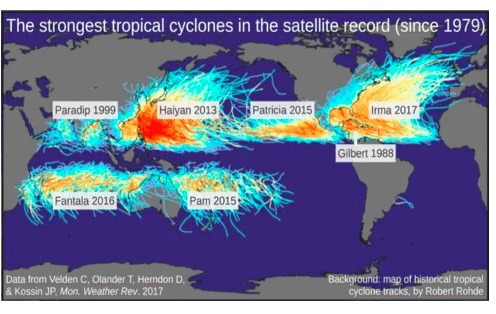On October 8, IPCC (Intergovernmental Panel for Climate Change) held its latest conference in Incheon, Republic of Korea. Its report examined the effects of limiting the global warming above pre-industrial levels. to 1.50 C by year 2100 [1]. The benefits would be enormous compared to the Paris agreement of 2015 which governments have agreed on to limit global temperature to not more than 20 C by 2100. In following this new pathway, the world would benefit from having a more sustainable and equitable development, as well as achieving our goals to eradicate poverty and reduce the threats of more extreme weather – rising sea levels, flooding, super typhoons, diminishing Arctic sea ice and the total disappearance of coral reefs. For example, global sea level rise would be 10 cm lower and the Arctic ocean of sea ice in summer would be once per century with global warming of 1.50 C compared with at least once per decade with 20 C. Coral reefs would decline by 70-90% with 1.50 C.
The report finds that limiting global warming to 1.50 C would require rapid far reaching unprecedented changes to all aspects of society – in land, energy, industry, buildings, transport and cities. Global human caused emissions of carbon dioxide would need to fall by about 45% from 2010 levels by 2030, reaching ‘net zero’ around 2050. This means that any remaining emissions would need to be balanced by removing CO2 from the air. The whole project of limiting CO2 emission would reduce challenging impacts on ecosystems, human health and well- being.
One of the key messages that is already striking in the report is that we are already experiencing the consequences of 10 C global warming.
The decisions we make today are critical in ensuring a safe and sustainable world for everyone. The next few years are probably the most important in the history of our planet and our civilization.
Now the science and technology exist but do we have the political will to achieve what is obviously the right goal?
Let us first take stock of how the world is doing right now. in terms of CO2 emission. We list the CO2 emission by major countries in 2015, the latest data available from International Energy Agency, IEA [2].
Table 1 CO2 emission by country in 2015, and 2020 GHG reduction target in MtCO2 (million tonnes of CO2) [2].
KEY FINDINGS FOR ENERGY GROWTH [3]
- Global energy demand increased by 2.1% in 2017. More than 40% of growth was driven by China and India. 72% was in fossil fuel, 25% by renewables, remainder by nuclear.
- Global energy related CO2 emissions rose by 1.4% in 2017 reaching a historic high of 5 Giga tonnes. However, USA, Mexico and Japan had a decline. The biggest decline came from USA, mainly because of the deployment of renewables.
- Oil: global demand rose by 1.6% (for 1.5 million barrels a day) in 2017
- Natural gas: global demand grew by 3%. Thanks in large part to abundant and relatively low cost supplies. China alone accounted for almost 30% of global growth.
- Coal: global demand rose 1% in 2017.
- Renewables: saw the highest growth meeting 1/4 of global energy demand. The leaders are USA and China.
- Electricity: global demand grew by 3.1% in 2017. This is higher than the overall increase in energy demand. China and India accounted for 70% of this growth. Output from nuclear plant rose by 26 terawatthours (TWh) in 2017.
- Energy efficiency. Improvements slowed down.
In all, the shocking news is that global energy demand grew by 2.1% in 2017, more than twice the growth rate in 2016. Instead of following the IPCC’s ‘Summary for Policymakers’ the world is going in the opposite direction, growing its economies by putting more CO2 into the air. This is especially true for China and India, which together represent more than 40% of the increase, while the US is at least developing renewables to counteract the CO2 emission. It is to be noted that global energy demand in 2017 actually reached an estimated 14,050 million tonnes of oil equivalent compared to 10,035 in 2000. A result of robust world economic growth of 3.7% and lower fossil fuel prices.
It is regrettable that to meet the demand for energy we just use fossil fuel which has met 70% of the growth in energy demand around the world.
The fundamental question we may ask: “Is it necessary for us to have such a growth rate today?” Maybe we are locked into our capitalist economic system. The changes advocated by IPCC in ‘Summary for policymakers’ simply cannot be reached by tweaking with fine adjustments. But how can we achieve the fundamental challenges envisaged by IPCC?
Now, what does it all mean for global warming? The consequences of what we have described above, our ‘Business as usual’ policy is very bad news for Climate Change.
Let us have a look at the dire predictions from IPCC [4].
Table 2 Scenarios of the 21st Century [4]
Figure 1 IPCC predictions to year 2100 with 4 scenario models [5].
Here we show global surface temperature change in degrees C versus year. As we know some of the extreme weather such as 4-5 category hurricanes, tropical cyclones, flooding, and sea level rise are already with us today. But the shocking result as shown on this graph is that irrespective of the model, by 2040 we shall probably reach a temperature rise of 1.50 C [6].
Figure 2 shows a very revealing graph about how close we are to 1,50 C [7]
As we have tabulated in Table 2 [4] and as we show in figures 1 and 2, we are merrily increasing CO2 emission, therefore some of the dire consequences will be here in 20 years-time [6].[7].
Today hurricane Michael is causing devastation in Florida and 5 other states. Yet again, another violent category 4 – 5 storm! The first question that is lingering in our minds is whether global warming has to do with the frequency of the tropical cyclones we are experiencing. There is a mounting consensus that we shall see more intense hurricanes as a consequence of anthropogenic climate change. But there is no scientific proof.
Figure 3- Date and location of the strongest tropical cyclones since 1979
This data shows an increase in most ocean basins across the globe. The strongest storms for the major storm regions are Western and Eastern North Pacific, North Indian, South Indian, South Pacific, Caribbean/Gulf of Mexico and open North Atlantic. Of these seven regions, five had the strongest storm on record in the past five years, which would be extremely unlikely just by chance [8].
Tropical storms are powered by evaporation of seawater. As the sea warms, the speed limit of the hurricane wind goes up. Analysis shows that these storms are moving more slowly, dumping more water on a particular region. There is also a poleward shift.
While there is not yet a ‘smoking gun’ – a single evidence that global warming causes stronger storms, the weight of evidence suggests that the prediction of more intense and wetter tropical cyclones we are observing is coming to pass.
EPILOGUE OR APOCALYPSE?
IPCC, with contributions from more than 1000 eminent global scientist, is doubtless the world’s best authority on climate change. In its recent ‘Summary for Policymakers’ report, representatives from the 190 participating countries eagerly agreed on the urgency and extremity of the global climate situation. Yet, at the conclusion of the conference, governments return to ‘business as usual’, growing their economies and pumping more GHG into the atmosphere, quite oblivious of the dire predictions of IPCC that they have just agreed to. The IPCC report will be a key scientific input into the December 2018 Katowice Climate Change Conference in Poland where governments will be reviewing the Paris Agreement.
Since the earth has warmed by 10 C from pre-industrial age, extreme weather in terms of unprecedented strong hurricanes and their destructive power is already evident in many parts of the world.
A visitor from outer space looking at the current state of the world might comment, “Are these Earthlings crazy, irrational or simply out of their minds? They are intelligent creatures, and they have developed sophisticated technology to enable them to predict the future under different scenarios. On top of this they have already seen some examples of the devastation caused by extreme weather. Yet, the governments are not changing course, they insist on this suicidal path which they know will lead to further disasters with untold unprecedented suffering for an even greater number of people. So, are they insane?”
Any reader of this article should reflect soberly on what an individual can do to alleviate and mitigate the coming disasters not in the long-term future but in just decades time. Can we vote sensible politicians dedicated to the environment into the government, or is it more effective to organize citizen action groups to put pressure and radically change our government? This is particularly relevant to the millennials and those coming of age, the 18-year olds, because they have most to lose.
Can society come together at this very critical juncture? Urgent action is needed for our own future and that of generations to come.
REFERENCES
[1] 2018/24/PR IPCC PRESS RELEASE 8 October 2018 Summary for Policymakers of IPCC Special Report on Global Warming of 1.5ºC approved by governments
[2] CO2 Emissions from Fuel Combustion- International Energy Agency
[3] Global energy and CO2 status report 2017
[4] 3.5 IPCC Scenarios of the 21st Century- www.ipcc.ch/ipccreports/tar/
[5] Long-term Climate Change: Projections, Commitments and IPCC
[6] Major Climate Report Describes a Strong Risk of a Crisis
[7] Climate Change: Even worse than we thought! Sierra club
[8] Does global warming make tropical cyclones stronger? Real Climate strongest tropical cyclones www.realclimate.org/index…/does-global-warming-make-tropical-cyclones-stronger?
Gioietta Kuo, MA Cambridge, PhD in nuclear physics at Birmingham, Atlas Fellow at St Hilda’s College, Oxford. She spent 12 years at Princeton University Plasma Physics Lab and has over 70 professional articles and over 100 articles on environmental problems featured in World Future Review (wfs.org), amcips.org, the MAHB and other worldwide think tanks. Additionally, she has published work in ‘People’s Daily’ and ‘World Environment’ – Magazine of the Chinese Ministry of Environmental Protection, and others in China. She can be reached at <kuopet@comcast.net.>
The views and opinions expressed through the MAHB Website are those of the contributing authors and do not necessarily reflect an official position of the MAHB. The MAHB aims to share a range of perspectives and welcomes the discussions that they prompt.

